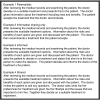The context influences doctors' support of shared decision-making in cancer care
- PMID: 17551491
- PMCID: PMC2359664
- DOI: 10.1038/sj.bjc.6603841
The context influences doctors' support of shared decision-making in cancer care
Abstract
Most cancer patients in westernised countries now want all information about their situation, good or bad, and many wish to be involved in decision-making. The attitudes to and use of shared decision-making (SDM) by cancer doctors is not well known. Australian cancer clinicians treating breast, colorectal, gynaecological, haematological, or urological cancer were surveyed to identify their usual approach to decision-making and their comfort with different decision-making styles when discussing treatment with patients. A response rate of 59% resulted in 624 complete surveys, which explored usual practice in discussing participation in decision-making, providing information, and perception of the role patients want to play. Univariate and multivariate analyses were performed to identify predictors of use of SDM. Most cancer doctors (62.4%) reported using SDM and being most comfortable with this approach. Differences were apparent between reported high comfort with SDM and less frequent usual practice. Multivariate analysis showed that specialisation in breast or urological cancers compared to other cancers (AOR 3.02), high caseload of new patients per month (AOR 2.81) and female gender (AOR 1.87) were each independently associated with increased likelihood of use of SDM. Barriers exist to the application of SDM by doctors according to clinical situation and clinician characteristics.
Figures
Similar articles
-
Factors which motivate cancer doctors to involve their patients in reaching treatment decisions.Patient Educ Couns. 2011 Aug;84(2):229-35. doi: 10.1016/j.pec.2010.10.018. Epub 2010 Nov 26. Patient Educ Couns. 2011. PMID: 21112174
-
Involving patients in decision making and communicating risk: a longitudinal evaluation of doctors' attitudes and confidence during a randomized trial.J Eval Clin Pract. 2004 Aug;10(3):431-7. doi: 10.1111/j.1365-2753.2004.00502.x. J Eval Clin Pract. 2004. PMID: 15304143 Clinical Trial.
-
Patient and observer ratings of physician shared decision making behaviors in breast cancer consultations.Patient Educ Couns. 2012 Jul;88(1):93-9. doi: 10.1016/j.pec.2012.01.008. Epub 2012 Feb 10. Patient Educ Couns. 2012. PMID: 22322069
-
Implementing and evaluating shared decision making in oncology practice.CA Cancer J Clin. 2014 Nov-Dec;64(6):377-88. doi: 10.3322/caac.21245. Epub 2014 Sep 8. CA Cancer J Clin. 2014. PMID: 25200391 Review.
-
Shared decision-making in the context of menopausal health: where do we stand?Maturitas. 2009 Jul 20;63(3):169-75. doi: 10.1016/j.maturitas.2009.01.013. Epub 2009 Mar 9. Maturitas. 2009. PMID: 19272720 Review.
Cited by
-
Using patient and physician perspectives to develop a shared decision-making framework for colorectal cancer.Implement Sci. 2009 Dec 24;4:81. doi: 10.1186/1748-5908-4-81. Implement Sci. 2009. PMID: 20034402 Free PMC article.
-
Demographic Disparities and Factors Influencing Cancer Treatment Decision-Making.J Cancer Educ. 2025 Feb 3. doi: 10.1007/s13187-025-02570-w. Online ahead of print. J Cancer Educ. 2025. PMID: 39894898
-
"I need to know what makes somebody tick …": Challenges and Strategies of Implementing Shared Decision-Making in Individualized Oncology.Oncologist. 2019 Apr;24(4):555-562. doi: 10.1634/theoncologist.2017-0615. Epub 2018 Sep 6. Oncologist. 2019. PMID: 30190300 Free PMC article.
-
Shared decision making in the treatment of stage I non small cell lung cancer-a choice which should equally involve both sides.Ann Transl Med. 2017 Sep;5(17):359. doi: 10.21037/atm.2017.06.03. Ann Transl Med. 2017. PMID: 28936453 Free PMC article. No abstract available.
-
Japanese physicians' preferences for decision making in rheumatoid arthritis treatment.Patient Prefer Adherence. 2016 Jan 28;10:107-13. doi: 10.2147/PPA.S95346. eCollection 2016. Patient Prefer Adherence. 2016. PMID: 26869774 Free PMC article.
References
-
- Anderson R, Funnell M, Butler P, Arnold M, Fitzgerald J, Feste C (1995) Patient empowerment: results of a randomized controlled trial. Diabetes Care 18: 943–949 - PubMed
-
- Beaver K, Luker KA, Owens RG, Leinster SJ, Degner LF, Sloan JA (1996) Treatment decision making in women newly diagnosed with breast cancer. Cancer Nurs 19: 8–19 - PubMed
-
- Braddock III CH, Edwards KA, Hasenberg NM, Laidley TL, Levinson W (1999) Informed decision making in outpatient practice: time to get back to basics. JAMA 282: 2313–2320 - PubMed
-
- Bruera E, Willey JS, Palmer JL, Rosales M (2002) Treatment decisions for breast carcinoma: patient preferences and physician perceptions. Cancer 94: 2076–2080 - PubMed
-
- Charles C, Gafni A, Whelan T (1997) Shared decision-making in the medical encounter: what does it mean? (or it takes at least two to tango). Soc Sci Med 44: 681–692 - PubMed
MeSH terms
LinkOut - more resources
Full Text Sources
Research Materials


